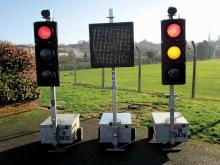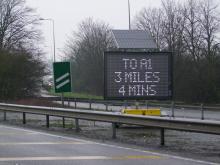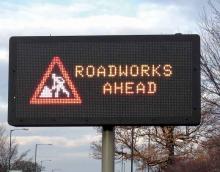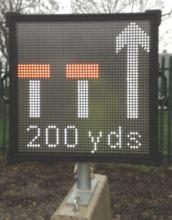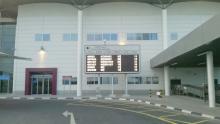Variable message signs are increasingly seen on the world’s motorways. World Highways looks at some of the latest developments
UK manufacturer of temporary, solar powered variable message signs, Bartco UK, has unveiled what it says is the first temporary VMS designed for use within work zones. Bartco said that its HD Quattro was developed in response to feedback from customers requiring a product to affirm on-site speed limits for work zone vehicles. The unit is designed to show limited amounts of inform
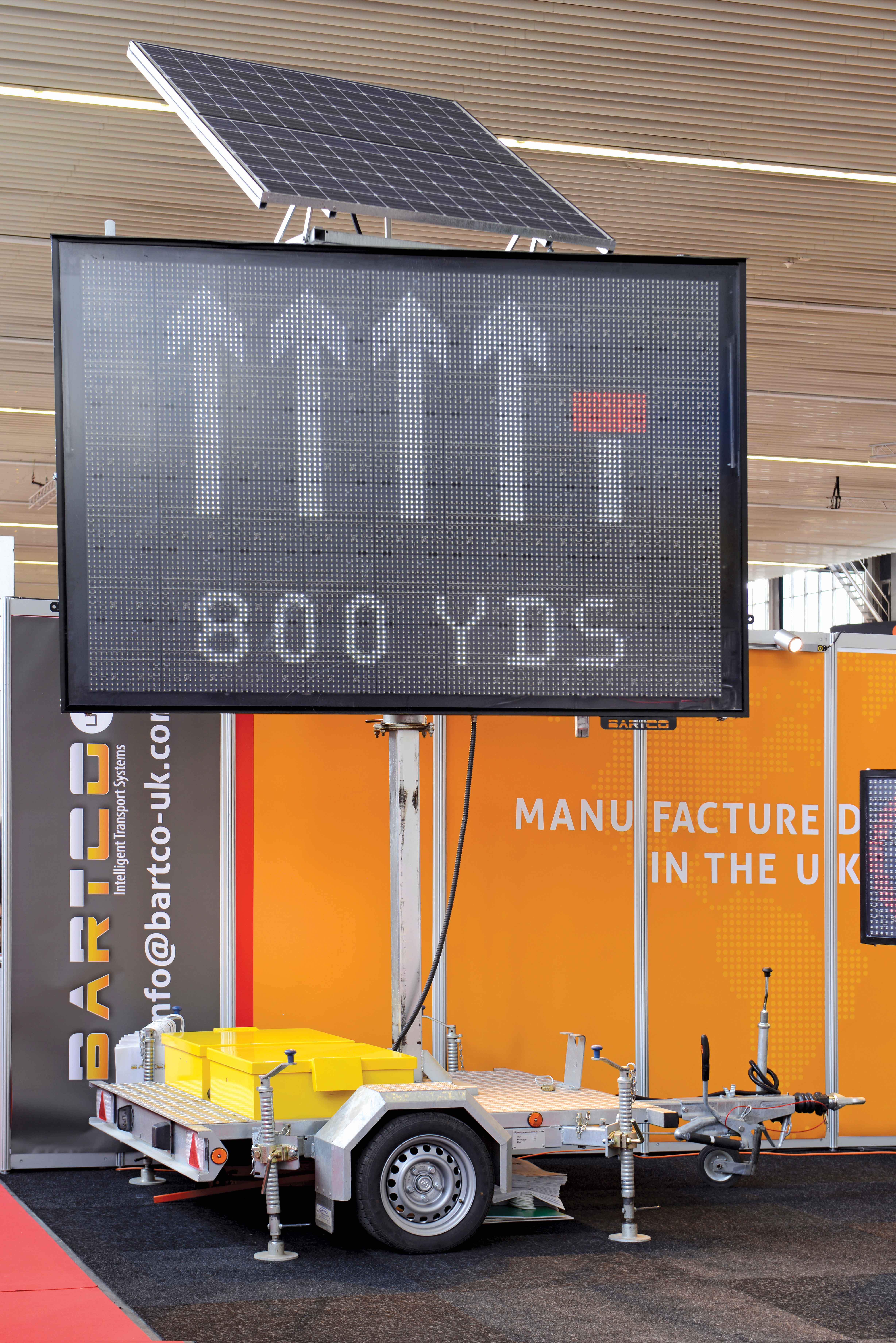
The HD VMS-C from Bartco, a two-colour VMS with a dual colour matrix
Variable message signs are increasingly seen on the world’s motorways. World Highways looks at some of the latest developments
UK manufacturer of temporary, solar powered variable message signs, Bartco UK, has unveiled what it says is the first temporary VMS designed for use within work zones. Bartco said that its HD Quattro was developed in response to feedback from customers requiring a product to affirm on-site speed limits for work zone vehicles. The unit is designed to show limited amounts of information, such as speed roundels. Bartco said that the 600mm x 600mm, free-standing, 12v battery-powered device is the smallest in its portfolio. Also available in mains-powered format, the HD Quattro can be used within a fixed, permanent context on urban highways with speed limits of up to 65kph (40mph). Weighing below 10kg, the lightweight sign may be positioned manually.
Bartco is also launching what it believes may be the first two-colour VMS of its size to feature a 126 pixel x 84 pixel dual colour matrix.
The 2,730mm x 1,850mm HD VMS-C offers higher resolution than standard VMS. It was developed to enable traffic management firms to clearly display - in high-impact red and white rather than standard amber - information regarding up to five lanes.
Bartco UK's product range includes its own solar IP multiuse trailers; branded CCTV, radar and ANPR products; as well as VMS and the Web Studio sign management system. Its integrated packages include journey time, overheight, Safelane and works egress solutions.
Last September, the company teamed up with Mobile Visual Information Systems (MVIS) to develop a journey time solution (JTS) for contractors7456 Bam 2567 Morgan Sindall Joint Venture and 2319 Costain, both contracted by 8100 Highways England. The JTS comprises 157 A and C portable VMS, manufactured in the UK by Bartco UK, along with 50 3957 Vysionics Vector integrated ANPR cameras and MVIS’ Web Studio sign management system. It forms part of a customer experience pilot project on the M1 corridor, which uses smart motorway roadworks at three sites between junctions 42 and 15 and went live in summer 2015.
Meanwhile, in the US,8027 SES America’s energy-efficient M6000 series of dynamic messaging signs, which require no cooling or ventilation, has received full approval for application on the Georgia highway system. The M6000 comes in an assortment of sizes and is available in both colour and amber, where amber is offered in solar- or mains-power versions.
SESA, based in Rhode Island in the US, says the product also exceeds NEMA TS4 and NTCIP Dynamic Message Sign standards.
The M6000 uses web-based software in conjunction with SESA’s SCUV6 dynamic message sign controller and can be supplied in front, walk-in and SESA’s rear access design, complete with platform and top-hinged door panels to protect workers from the weather.
The SCU6 Multi-DMS Controller allows the user to view the displayed message or graphic, change the message or graphic and get system diagnostics, all online using any web browser. It uses password-protected software, also accessible with a standard web browser. The controller has optional WiFi access from a smartphone or laptop on the DMS Controller.
SESA also reports that it recently completed the manufacturing and installation of 12 full colour LED Dynamic Trailblazer Signs for the2630 Michigan Department of Transportation, with another six for delivery in the near future. The signs are part of the integrated corridor management along the I-75 highway, designed by Michigan’s DoT. Each sign is part of SESA’s Messenger 5000 embedded DMS series, a line of embedded DMS designed to display travel time, toll rate, lane status or traffic control information.
Many motorway operators are becoming sensitive to issues over the pricing of fuel along routes and starting to make sure drivers are aware of their choices for buying it. It used to be a static sign was about all a driver could hope for. But now, with variable message sign technology advancements, fuel comparisons are being displayed to help drivers make their choice of service stops.
Variable message signs from337 Swarco Traffic are playing a critical part in a high-profile trial to provide drivers with real-time fuel prices in the UK. The signs, manufactured to order in less than three months, are positioned along a stretch of the M5 motorway between Bristol and Exeter in south-west England.
The signs have been made for maximum legibility. Each character is 420mm high in order to meet the exacting standards laid down by Highways England and the relevant EU legislation, according to Swarco.
They integrate with a bespoke system that monitors pump prices and enable the displayed prices to be updated within one minute of any change at the pumps. They also integrate with a second independent database to ensure the prices are verified on a daily basis.
Swarco’s sign control system is hosted in a datacentre for maximum reliability and availability. Communication with the signs is by a secure VPN to ensure that the prices cannot be tampered with.
The trial will run until October 2017. Highways England wants to determine whether increasing the transparency of fuel prices at motorway service areas has an impact on driver behaviour. This could be the number of stops made at service areas, the number of fatigue and fuel related incidents, and on fuel pricing.
Carl Dyer of Swarco Traffic says that a key feature of the trial is close cooperation between lead consultant2782 WSP 2693 Parsons Brinckerhoff, Highways England, the contractor and other technology partners. “Since the award of the contract in December 2015, all parties have worked closely to have the trial up and running in record time,” he said.
Meanwhile, in London, Swarco’s full matrix driver information signs are being installed for the first time across the2387 Transport for London (TfL) strategic route network.
The full colour signs are fully programmable and deliver high levels of clarity, energy efficiency and life expectancy. They have been integrated with TfL’s proprietary controls, making them compatible with the London driver information system. They also use the existing radio communications network.
Swarco said it is working with TfL’s Traffic Control Management Service contractors to help upgrade the capital’s roadside infrastructure. Seven signs haave been installed on several major arterial routes, with another seven to arrive in the coming months.
Jeremy Cowling, managing director of Swarco Traffic says that the new generation signs have full integration capabilities: “Having the ability to easily integrate with TfL’s existing or proprietary software means that where and how the signs are used and installed is virtually limitless and protects their legacy investment.”
There is still a need for fast deployment of temporary signs, variable and otherwise, in times of unexpected but essential diversions or lengthy emergency rerouiting of traffic. The latest vertical arrow board trailers from7750 Wanco have a display panel that remains vertical at all times and can be rotated to face traffic.
The display is raised and lowered on a vertical tower that allows the display to be rotated for orienting toward traffic without moving the trailer. When the tower is lowered for transport or storage, the display panel rests in a cradle that keeps it secure.
They also feature W|ECO technology, a power system that benefits the environment without sacrificing performance, according to Wanco.
Wanco said that W|ECO batteries never need maintenance. Wanco’s arrow board trailers require no permanent installation or wiring and are constructed of rigid, tubular steel, with all joints welded. Bolt-on fenders can be replaced if damaged.
For simple deployment, a heavy-duty winch with safety brake allows one person to raise the arrow board on a telescoping and rotatable mast. When the tower is lowered for transport or storage, the display panel rests in a cradle that keeps it secure.
The LED lamps consume 85% less power than those used on traditional arrow boards, Smaller and fewer batteries results in greatly reduced lead content — 80% less, when compared to traditional arrow board batteries. Additionally, W|ECO batteries are fully sealed and will not leak or spill. Because they require no maintenance, the batteries last longer with fewer replacements.
Additional solar units and batteries can be added as options.
During the board’s manufacturing process, Wanco products are powder coated, not painted. Powder coating emits near-zero volatile organic compounds and nearly all over-spray is reclaimed and reused. In fact, for the environmentally concerned renter or purchaser, Wanco said that when its arrow board reaches the end of its useful life — “usually because of a collision; we have never seen one wear out’ - nearly every component can be recycled.
UK manufacturer of temporary, solar powered variable message signs, Bartco UK, has unveiled what it says is the first temporary VMS designed for use within work zones. Bartco said that its HD Quattro was developed in response to feedback from customers requiring a product to affirm on-site speed limits for work zone vehicles. The unit is designed to show limited amounts of information, such as speed roundels. Bartco said that the 600mm x 600mm, free-standing, 12v battery-powered device is the smallest in its portfolio. Also available in mains-powered format, the HD Quattro can be used within a fixed, permanent context on urban highways with speed limits of up to 65kph (40mph). Weighing below 10kg, the lightweight sign may be positioned manually.
Bartco is also launching what it believes may be the first two-colour VMS of its size to feature a 126 pixel x 84 pixel dual colour matrix.
The 2,730mm x 1,850mm HD VMS-C offers higher resolution than standard VMS. It was developed to enable traffic management firms to clearly display - in high-impact red and white rather than standard amber - information regarding up to five lanes.
Bartco UK's product range includes its own solar IP multiuse trailers; branded CCTV, radar and ANPR products; as well as VMS and the Web Studio sign management system. Its integrated packages include journey time, overheight, Safelane and works egress solutions.
Last September, the company teamed up with Mobile Visual Information Systems (MVIS) to develop a journey time solution (JTS) for contractors
Meanwhile, in the US,
SESA, based in Rhode Island in the US, says the product also exceeds NEMA TS4 and NTCIP Dynamic Message Sign standards.
The M6000 uses web-based software in conjunction with SESA’s SCUV6 dynamic message sign controller and can be supplied in front, walk-in and SESA’s rear access design, complete with platform and top-hinged door panels to protect workers from the weather.
The SCU6 Multi-DMS Controller allows the user to view the displayed message or graphic, change the message or graphic and get system diagnostics, all online using any web browser. It uses password-protected software, also accessible with a standard web browser. The controller has optional WiFi access from a smartphone or laptop on the DMS Controller.
SESA also reports that it recently completed the manufacturing and installation of 12 full colour LED Dynamic Trailblazer Signs for the
Many motorway operators are becoming sensitive to issues over the pricing of fuel along routes and starting to make sure drivers are aware of their choices for buying it. It used to be a static sign was about all a driver could hope for. But now, with variable message sign technology advancements, fuel comparisons are being displayed to help drivers make their choice of service stops.
Variable message signs from
The signs have been made for maximum legibility. Each character is 420mm high in order to meet the exacting standards laid down by Highways England and the relevant EU legislation, according to Swarco.
They integrate with a bespoke system that monitors pump prices and enable the displayed prices to be updated within one minute of any change at the pumps. They also integrate with a second independent database to ensure the prices are verified on a daily basis.
Swarco’s sign control system is hosted in a datacentre for maximum reliability and availability. Communication with the signs is by a secure VPN to ensure that the prices cannot be tampered with.
The trial will run until October 2017. Highways England wants to determine whether increasing the transparency of fuel prices at motorway service areas has an impact on driver behaviour. This could be the number of stops made at service areas, the number of fatigue and fuel related incidents, and on fuel pricing.
Carl Dyer of Swarco Traffic says that a key feature of the trial is close cooperation between lead consultant
Meanwhile, in London, Swarco’s full matrix driver information signs are being installed for the first time across the
The full colour signs are fully programmable and deliver high levels of clarity, energy efficiency and life expectancy. They have been integrated with TfL’s proprietary controls, making them compatible with the London driver information system. They also use the existing radio communications network.
Swarco said it is working with TfL’s Traffic Control Management Service contractors to help upgrade the capital’s roadside infrastructure. Seven signs haave been installed on several major arterial routes, with another seven to arrive in the coming months.
Jeremy Cowling, managing director of Swarco Traffic says that the new generation signs have full integration capabilities: “Having the ability to easily integrate with TfL’s existing or proprietary software means that where and how the signs are used and installed is virtually limitless and protects their legacy investment.”
There is still a need for fast deployment of temporary signs, variable and otherwise, in times of unexpected but essential diversions or lengthy emergency rerouiting of traffic. The latest vertical arrow board trailers from
The display is raised and lowered on a vertical tower that allows the display to be rotated for orienting toward traffic without moving the trailer. When the tower is lowered for transport or storage, the display panel rests in a cradle that keeps it secure.
They also feature W|ECO technology, a power system that benefits the environment without sacrificing performance, according to Wanco.
Wanco said that W|ECO batteries never need maintenance. Wanco’s arrow board trailers require no permanent installation or wiring and are constructed of rigid, tubular steel, with all joints welded. Bolt-on fenders can be replaced if damaged.
For simple deployment, a heavy-duty winch with safety brake allows one person to raise the arrow board on a telescoping and rotatable mast. When the tower is lowered for transport or storage, the display panel rests in a cradle that keeps it secure.
The LED lamps consume 85% less power than those used on traditional arrow boards, Smaller and fewer batteries results in greatly reduced lead content — 80% less, when compared to traditional arrow board batteries. Additionally, W|ECO batteries are fully sealed and will not leak or spill. Because they require no maintenance, the batteries last longer with fewer replacements.
Additional solar units and batteries can be added as options.
During the board’s manufacturing process, Wanco products are powder coated, not painted. Powder coating emits near-zero volatile organic compounds and nearly all over-spray is reclaimed and reused. In fact, for the environmentally concerned renter or purchaser, Wanco said that when its arrow board reaches the end of its useful life — “usually because of a collision; we have never seen one wear out’ - nearly every component can be recycled.

